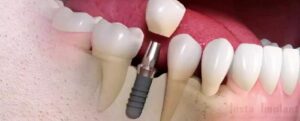Book a dental appointment
Examination of a patient and planning treatment
This stage includes a thorough anamnesis of general and oral cavity diseases – we exclude contraindications to implant treatment and get an idea what dental treatments the patient has had earlier. During the oral cavity examination, we check the mucosa, teeth, gums and attachment apparatus. We check the occlusion and the space requirements to place the implants. If necessary, we can refer the patient for treatment before placing implants (cavities, inflammations of root and attachment apparatus etc.).
Intraoral pictures: help us to plan procedures necessary for placing an implant and later seating of a crown.
X-rays: are necessary to assess the shape and state of the jawbones and localise the most important structures that must not be damaged during surgery, including nerves, their exit points and the sinus. Sometimes regular X-rays are not sufficient to get satisfactory information. In such case, a 3D X-ray examination should be conducted.
We can prepare the most optimal treatment plan based on the gathered data.

Placing an implant
Depending on the situation, placing an implant is performed in one or two stages.
A one-stage procedure means that an incision is made into the gum to open up the bone tissue. A hole will be made into the jawbone for placing an implant using special drills. The implant is inserted into the prepared hole and an attachment element – a healing screw – is placed on it. The gum incision is sewn up so that the healing screw remains visible. This attachment element will be removed after 3–6 months (the time varies depending on the used implant system and clinical parameters, such as bone density that influences the stability of the implant). After the healing screw is removed, it is replaced with an abutment to connect the implant with the crown that imitates the natural tooth.
A two-stage procedure includes procedures that are similar to the one-stage procedure, but instead of the healing screw, a cover screw is placed on the implant for the time of ossification and the gum will be sewn up over them. Healing occurs in a closed environment under the gum. After the necessary healing period has passed, the gum will be cut open again and the cover screw opened up. The screw is replaced with an abutment and the implant is then ready for the placement of a crown.
A two-stage procedure is usually necessary in cases where in addition to placing an implant there is a need to increase the mass of the jawbone with bone material or using regenerative technique. The procedure is used also in cases where upon placing an implant it is revealed that the initial stability of the implant might not be optimal due to bone density.
Moulds for dentures: after the gum has completely healed (after 4–6 weeks), a mould is taken from the abutment and teeth so that the dental technician can make an appropriate model at the laboratory. The model helps to build a restoration, resembling the natural teeth as much as possible, which is placed on the implant.
Placing a restoration into the mouth: the restorations made at the laboratory will be tested in the patient’s mouth on the abutment connected to the implant. The fit and appearance of the restoration is assessed and the occlusion is checked. Sometimes several checks have to be made before the dentist and the patient are satisfied with the result and the restoration can be placed into the mouth permanently.
Read more:
- What is a dental implant
- The advantages of implants compared to conventional dentures
- Who is suitable for dental implants
- Planning treatment
- Complications of implantation
- Caring for dental implants at home
Read more about our other dental treatment services here.
Read more about oral health here.
